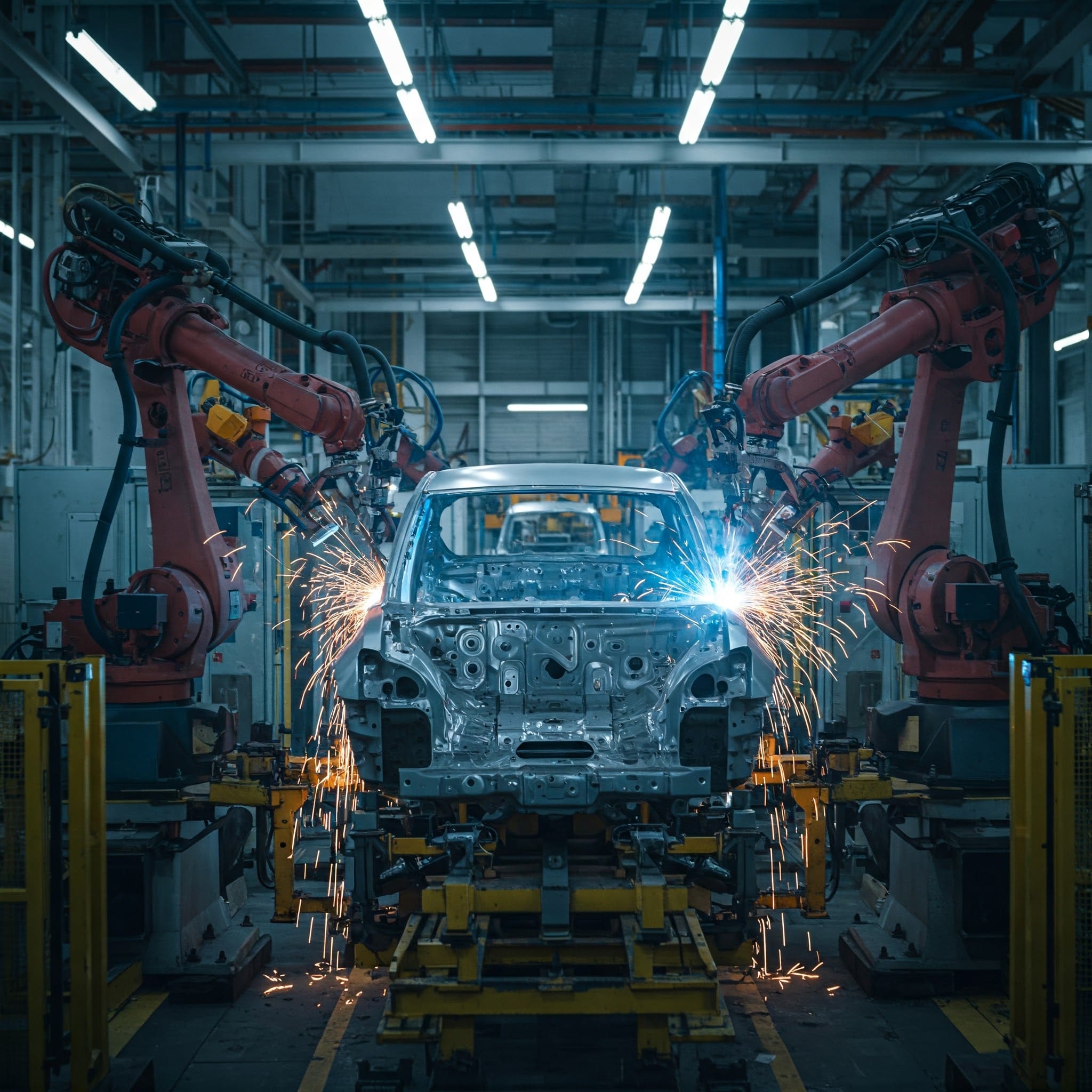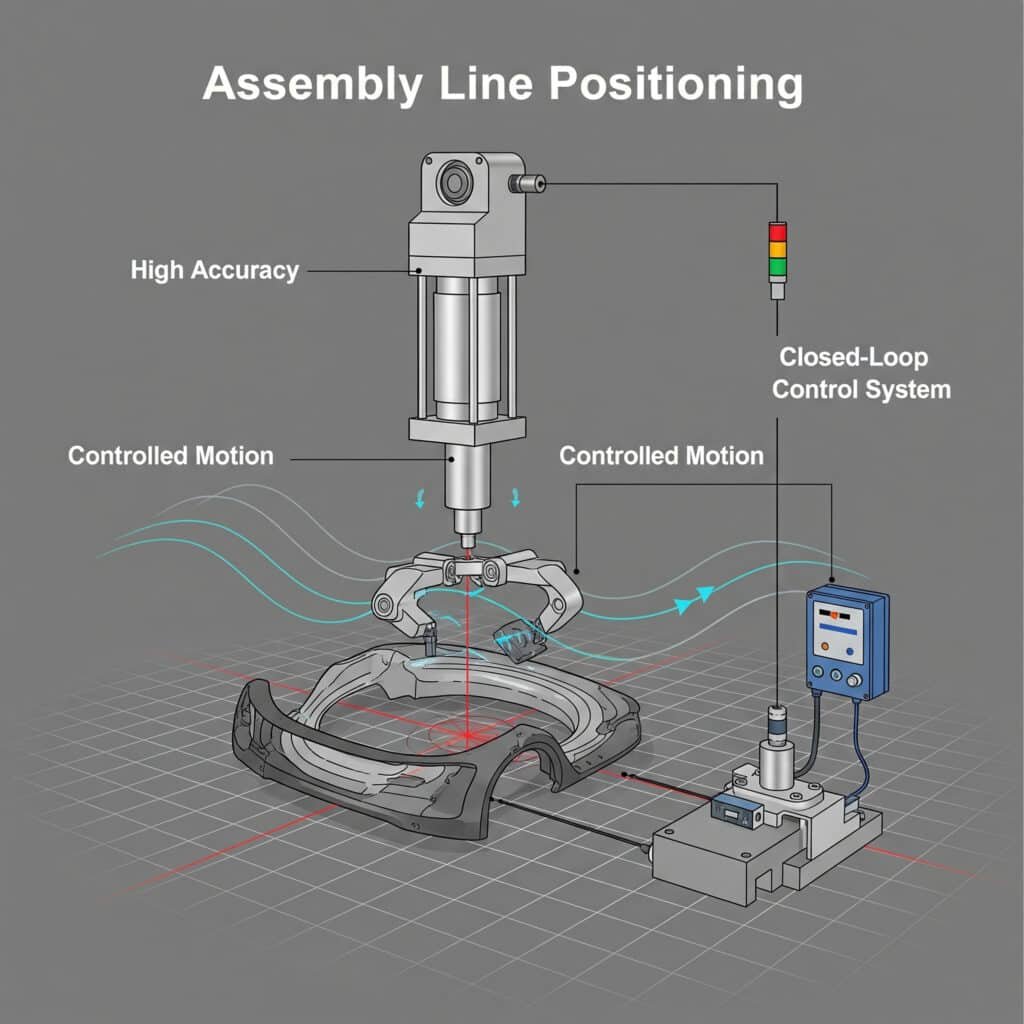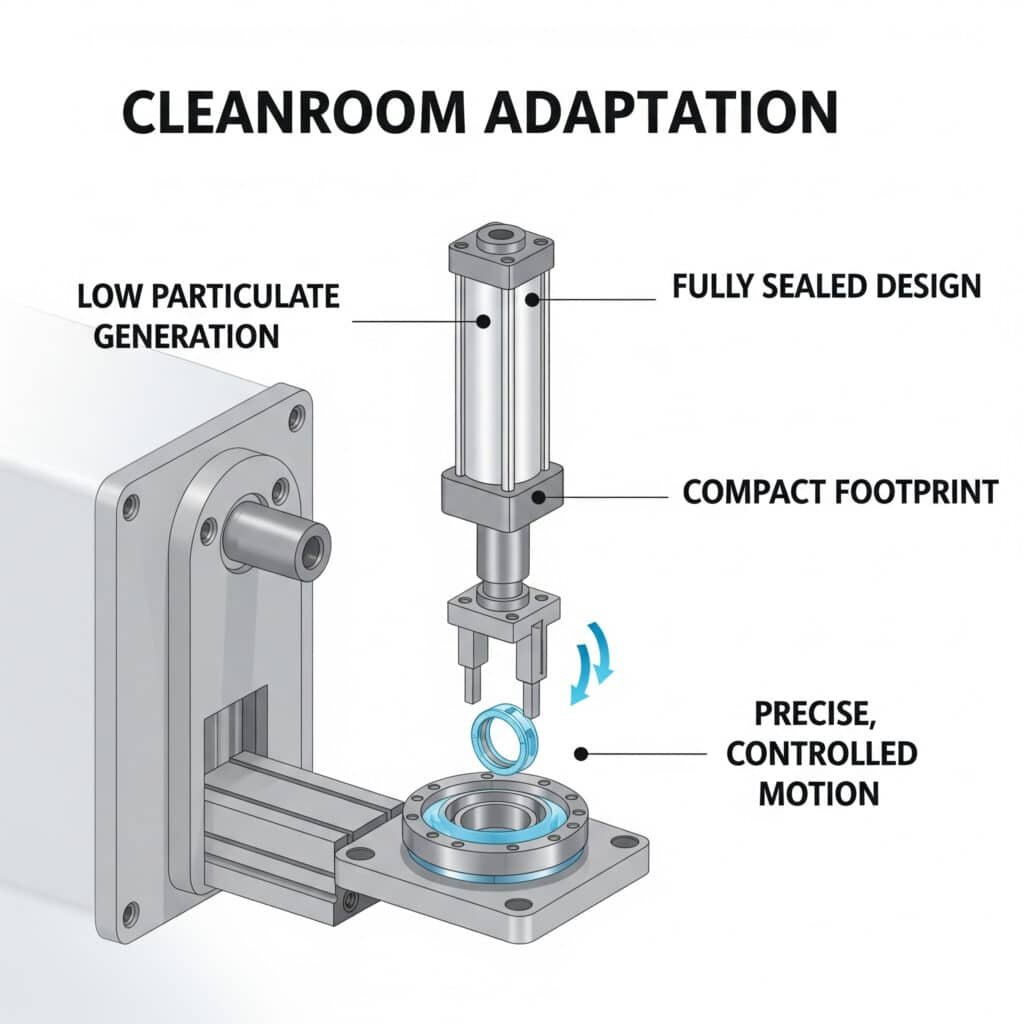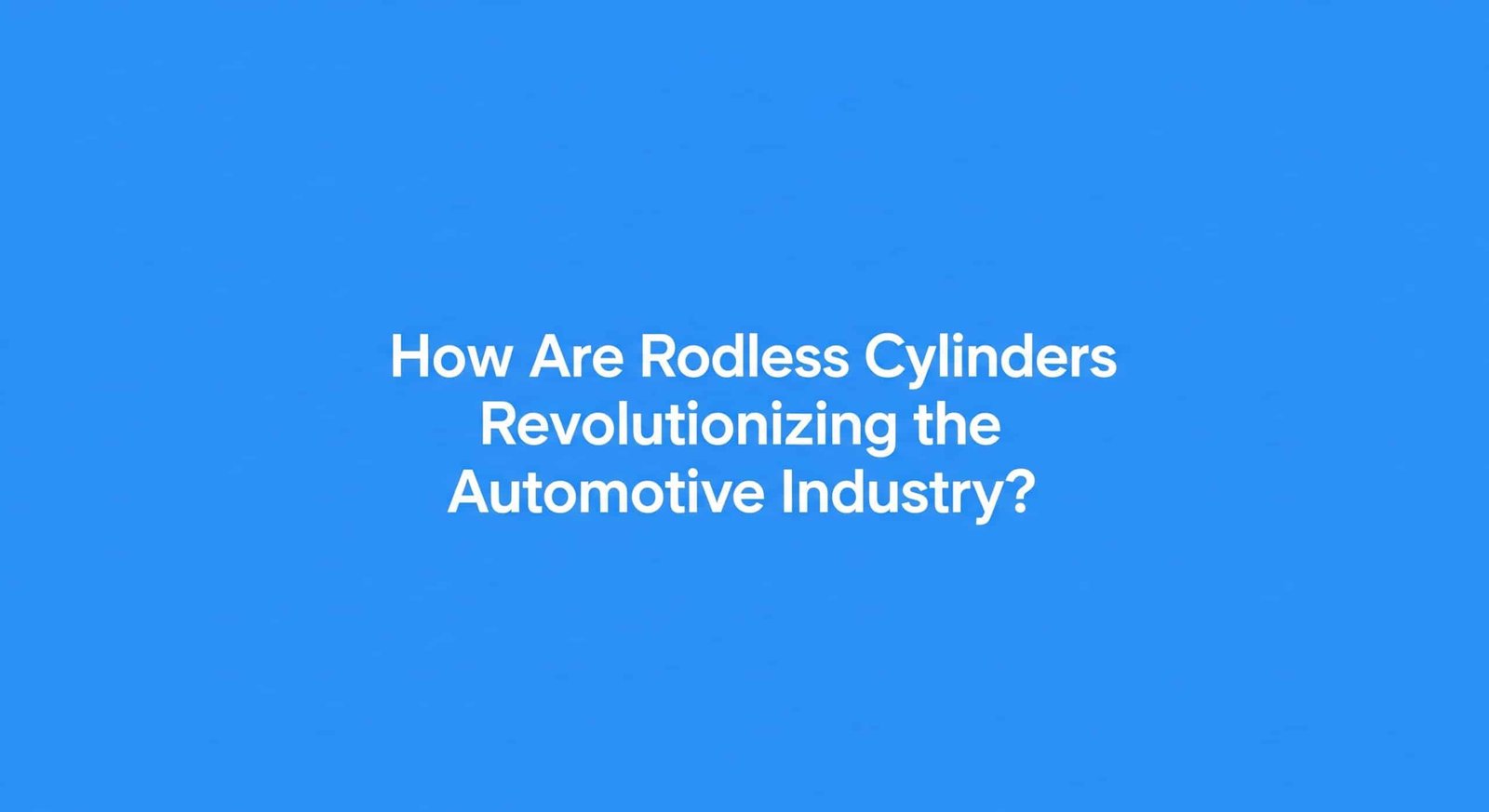
Are your automotive production lines struggling with space constraints and precision challenges? Many engineers in the automotive sector find that traditional pneumatic cylinders can’t deliver the compact, high-performance solutions needed for modern manufacturing processes. This is where rodless cylinders are changing the game.
Pneumatische cilinders zonder stangen are transforming automotive manufacturing by providing space-efficient designs for welding applications, enabling high-precision positioning for assembly lines, and meeting the stringent contamination control requirements of cleanroom environments – resulting in up to 50% smaller machine footprints and a 30-40% improvement in positioning accuracy.
I’ve worked directly with leading automotive manufacturers for over a decade, and I’ve seen firsthand how rodless cylinder technology has solved some of their most persistent automation challenges. Let me share the key applications where these innovative components are making the biggest impact.
Inhoudsopgave
- How Do Rodless Cylinders Improve Welding Gun Integration?
- What Makes Rodless Cylinders Essential for Assembly Line Positioning?
- What Makes Rodless Cylinders Ideal for Automotive Cleanroom Environments?
- Conclusie
- FAQs About Rodless Cylinders in Automotive Applications
How Do Rodless Cylinders Improve Welding Gun Integration?
Automotive welding lines are crowded, high-speed environments where every millimeter of space counts. Traditional pneumatic solutions often create more problems than they solve.
Rodless cylinders improve welding gun integration by providing a compact, powerful solution for positioning heavy spot welding guns in space-constrained robotic work cells. Their design eliminates the external piston rod, reducing the required installation length by nearly 50% compared to conventional cylinders and allowing for more flexible machine layouts.

Having implemented dozens of welding gun positioning systems, I’ve seen how the right rodless cylinder can dramatically improve both performance and maintainability.
Space Efficiency in Robotic Welding Cells
Space is a premium in modern automotive plants. Here’s how rodless cylinders create value:
Footprint Reduction Analysis
| Parameter | Traditional Cylinder (100mm bore, 500mm stroke) | Rodless Cylinder (100mm bore, 500mm stroke) | Voordeel |
|---|---|---|---|
| Overall Length | ~1200mm (stroke + body + rod) | ~650mm (stroke + carriage) | 46% reduction |
| Interference Zone | Large (moving rod) | Minimal (contained motion) | Enables tighter machine spacing |
| Gewicht | Hoog | Matig | Reduces load on robotic arms |
Load Capacity and Rigidity
Welding guns are heavy and require precise positioning. Rodless cylinders are uniquely suited to this challenge:
- High Load Support: Integrated guide systems handle heavy cantilevered loads.
- Moment Resistance: Wide bearing separation resists twisting forces during movement.
- Rigid Construction: Extruded aluminum bodies provide excellent stiffness.
Case Study: Body-in-White Welding Line
A major European car manufacturer was struggling with a body-in-white welding station. Their existing system with traditional cylinders was:
- Bulky and difficult to access for maintenance
- Prone to rod deflection, causing inconsistent weld quality
- Limited in speed due to high moving mass
We implemented a solution using our mechanically coupled rodless cylinders:
- Reduced machine footprint by 35%, improving maintenance access
- Integrated heavy-duty guide bearings to eliminate deflection
- Achieved 20% faster cycle times due to lower moving mass
The result was a significant improvement in both weld quality and production throughput. The key was leveraging the inherent space efficiency and rigidity of the rodless cylinder design.
What Makes Rodless Cylinders Essential for Assembly Line Positioning?
Modern automotive assembly requires a level of precision that was unheard of a decade ago. Rodless cylinders provide the accuracy and flexibility needed for these demanding tasks.
Rodless cylinders are essential for assembly line positioning because they offer superior accuracy over long strokes, provide smooth and controlled motion profiles critical for delicate component handling, and can be easily integrated with advanced sensor and control systems for closed-loop feedback.

From powertrain mating to dashboard installation, the precision offered by rodless cylinders is a critical enabler of modern vehicle assembly.
Precision and Control Capabilities
The design of rodless cylinders allows for several advanced control features:
- Continuous Position Sensing: Magnetic encoders provide real-time position feedback.
- Multi-position Stops: Easily implemented without complex external mechanisms.
- Smooth Acceleration/Deceleration: Proportional valves enable precise speed control.
- Low-friction Designs: Minimize stick-slip for consistent low-speed movement.
Application-Specific Precision Requirements
| Toepassing | Required Positional Accuracy | Key Rodless Cylinder Feature | Reason for Choice |
|---|---|---|---|
| Spot welding1 Guns | ±1.0mm | Robust guided rodless | High load capacity |
| Dashboard Installation | ±0,5mm | Long-stroke guided rodless | Stability over distance |
| Powertrain Mating | ±0,1 mm | High-precision guided rodless | Rigidity under load |
| Glass Installation | ±0.3mm | Magnetically coupled rodless | Smooth motion profile |
Real-World Implementation Strategy
When I helped a major American automotive manufacturer upgrade their door assembly station, we focused on these key elements:
Identifying Critical Positioning Points
- Door hinge locations required ±0.15mm accuracy
- Presenter movements needed smooth acceleration profiles
- Multiple position stops were required within one stroke
Selecting Appropriate Technology
- Implemented guided rodless cylinders with magnetic position sensing
- Added proportional flow control for speed management
- Integrated position verification feedback
Validation Methodology
- Established measurement protocols at installation
- Implemented ongoing verification procedures
- Created preventative maintenance schedules
The result was a 67% reduction in door-related quality issues and a 40% improvement in station throughput. The key success factor was understanding that positioning isn’t just about the cylinder itself but the entire control system surrounding it.
What Makes Rodless Cylinders Ideal for Automotive Cleanroom Environments?
Cleanroom environments2 in automotive manufacturing present unique challenges that conventional pneumatic solutions struggle to address effectively.
Rodless cylinders are ideal for automotive cleanroom environments because they generate minimal particulate emissions, offer sealed designs that prevent contamination, provide compact footprints for space-constrained clean areas, and deliver the precise control needed for sensitive component handling.

The increasing complexity of automotive electronics and battery production has dramatically expanded cleanroom requirements in the industry. Based on my experience implementing solutions in these environments, rodless cylinders offer distinct advantages.
Cleanroom Classification Requirements
Automotive cleanroom applications typically fall into these categories:
ISO Class 7-83 (Federal Standard 209E Class 10,000-100,000)
- Battery cell assembly
- Sensor manufacturing
- Electronic control unit production
ISO Class 6-7 (Federal Standard 209E Class 1,000-10,000)
- Camera and LIDAR4 component assembly
- Microchip integration
- Advanced driver assistance systems (ADAS)
Contamination Control Features in Rodless Cylinders
Modern rodless cylinder designs incorporate several features specifically beneficial in cleanroom environments:
Enclosed Motion Mechanisms
- Sealing bands prevent particle generation
- Internal lubrication systems reduce maintenance
- No external moving parts minimize contamination
Material Compatibility
- Non-outgassing seals and components
- Chemical-resistant surfaces
- Electrostatic discharge (ESD)5 compliant options
Specialized Cleanroom Adaptations
- External vacuum ports for particle extraction
- Low-particle generating lubricants
- Specialized cleaning protocols
Cleanroom Implementation Comparison
| Functie | Standard Pneumatic | Cleanroom Rodless Cylinders | Voordeel |
|---|---|---|---|
| Particle Generation | Moderate to High | Zeer laag | Maintains clean classification |
| External Lubrication | Required periodically | Sealed systems available | Reduces contamination risk |
| Cleaning Compatibility | Beperkt | Enhanced chemical resistance | Supports sanitization protocols |
| Ruimte-efficiëntie | Slecht | Uitstekend | Maximizes clean area utilization |
Electric vs. Pneumatic Rodless Options for Cleanrooms
While electric rodless actuators are often considered for cleanroom use, pneumatic rodless cylinders offer distinct advantages in certain applications:
- Lower heat generation (critical for temperature-sensitive processes)
- No electromagnetic interference with sensitive electronics
- Simplified explosion-proof implementation for battery manufacturing
- Generally lower cost for equivalent performance
I recently helped a battery manufacturer in Austria implement a cleanroom-compatible rodless cylinder system for their electrode stacking process. By selecting magnetically coupled rodless cylinders with specialized seals and internal lubrication, we achieved:
- Consistent ISO Class 7 compliance
- 30% faster cycle times than their previous electric actuator solution
- Significant cost savings on both initial investment and energy consumption
The key was understanding the specific cleanroom requirements and selecting the appropriate rodless cylinder variant with the right sealing and lubrication technology.
Conclusie
Rodless cylinders have become essential components in modern automotive manufacturing, delivering the space efficiency, precision, and reliability needed for welding integration, assembly line positioning, and cleanroom operations. By selecting the right rodless solution for each application, manufacturers can achieve significant improvements in quality, efficiency, and cost-effectiveness.
FAQ
What are the main types of rodless cylinders used in automotive manufacturing?
The main types include magnetic rodless cylinders (using magnetic coupling between the internal piston and external carriage), mechanical rodless cylinders (using mechanical connections like slotted bands), and guided rodless cylinders (with additional guide rails for handling side loads). Each type serves different automotive applications based on load requirements and precision needs.
How do rodless cylinders compare to traditional cylinders in automotive applications?
What are the main types of rodless cylinders used in automotive manufacturing?
The main types include magnetic rodless cylinders (using magnetic coupling between the internal piston and external carriage), mechanical rodless cylinders (using mechanical connections like slotted bands), and guided rodless cylinders (with additional guide rails for handling side loads). Each type serves different automotive applications based on load requirements and precision needs.
What maintenance is required for rodless cylinders in welding environments?
Rodless cylinders in welding environments require regular inspection of sealing bands for spatter damage, periodic cleaning of external surfaces, verification of magnetic coupler performance, and occasional lubrication according to manufacturer specifications. Properly maintained units typically require major service only every 10-15 million cycles.
Can rodless cylinders handle the heavy loads in automotive assembly?
Yes, modern rodless cylinders can handle substantial loads, with heavy-duty models supporting up to 200kg in horizontal applications. For extreme loads, guided rodless cylinders with additional bearing support can manage even greater forces while maintaining positioning accuracy within ±0.1mm.
What’s the typical return on investment for upgrading to rodless cylinders?
Most automotive manufacturers see ROI within 8-18 months after upgrading to rodless cylinders. The returns come from reduced maintenance costs (30-40% lower), improved quality (typically 25-50% fewer defects), space savings (40-60% smaller footprint), and increased throughput (15-30% higher) due to optimized motion profiles and reliability.
-
Provides a detailed explanation of resistance spot welding, a common process in automotive manufacturing used to join sheet metal parts by applying pressure and electrical current. ↩
-
Explains the concept of a cleanroom, a controlled environment that has a low level of pollutants such as dust, airborne microbes, and chemical vapors, which is essential for sensitive manufacturing. ↩
-
Details the ISO 14644-1 standard, which classifies the air cleanliness of cleanrooms and controlled environments based on the concentration of airborne particles. ↩
-
Describes the principles of LiDAR (Light Detection and Ranging), a remote sensing method that uses pulsed laser light to measure variable distances to the Earth, which is a key component in autonomous vehicles. ↩
-
Offers an explanation of Electrostatic Discharge (ESD), the sudden flow of electricity between two electrically charged objects, which can cause significant damage to sensitive electronic components. ↩



